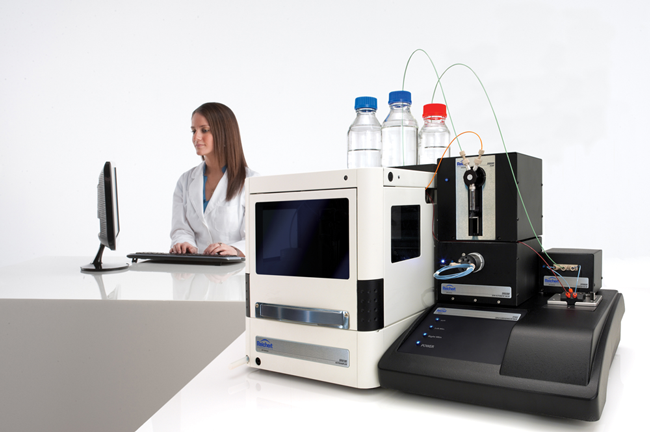The Do’s and Don’ts of SPR Experiments

Complete the form below to unlock access to ALL audio articles.
This type of information is not as readily available with other techniques where only end point information can be obtained. The fact that analysis is in real time and capable of being automated also makes it attractive to researchers.
In its most basic form, the idea of using the technique is this – via covalent coupling (permanent bond) or via capture (temporary bond), you attach a target molecule to the surface of a gold sensor chip which has been prior derivatized with a Self Assembled Monolayer (SAM) or further to a hydrogel. Then, flow the other half of the binding pair (analyte) over the surface. Dependent on the amount of target coupled, the molecular weight ratio of the molecules involved, the number of binding sites on the target and analyte, and the concentrations of analyte injected, you will see a characteristic (for the pair) association binding curve if there is an interaction between the two biomolecules. This binding curve will decay (dissociate) once fresh analyte is no longer supplied to the sensor chip. The interaction is followed in real time as a change in refractive index units with time.

While the instrument setup and analysis may not always seem straightforward, there are certain pointers that can be followed to simplify the method development process and obtain the best data.
Method Development
Do see if anything has been published in the literature for your compounds (or related compounds), especially using SPR. This offers a good starting point if you are unsure of the conditions you want to try.
Do use the knowledge you have gained while working with your compounds using other techniques to help with development work for SPR. In particular, knowing stability in acid, base or ionic solvents can be useful in determining the proper regeneration solution. Also, if you have prior knowledge of the equilibrium dissociation constant (KD) it will give you an idea of the concentrations you may want to inject.
Do start with standard buffers for the coupling process. For example, Phosphate Buffered Saline (PBS) or HEPES Buffered Saline (HBS) with or without added tween 20. Always use a pH around 7 (7.4 is typical) unless you know your samples are not stable at that pH.
Do include the additives needed to see binding between the target and analyte. For example, dithiothreitol (DTT), magnesium chloride, manganese chloride, or some other additive may be needed depending on the type of target and analyte samples being analyzed.
Do start development work with amine coupling, unless you know for certain that a lower pH will denature/deactivate your target or you have a tag on your target that you want to use to couple to the sensor chip. Consider where the binding pocket is (if known) when determining how to couple the target. Also, if possible, consider switching which half of the binding pair is coupled..
Do use a high capacity hydrogel sensor chip when the molecular weight of the target is much higher than the analyte (dextran is the most popular but other types can also be used).
Don’t get discouraged if initial experiments don’t go as planned.
Do have a backup plan, for example, try a capture experiment if direct coupling doesn’t work.

Getting the Best Results
Do plan on immobilizing a minimal amount of target to obtain curvature in your analyte injections. For initial experiments, aim for about 50-100 when looking at the ratio of the molecular weights of analyte/target times the amount of target immobilized (assuming 1 to 1 binding). You can refine the experiment later as needed. Keep in mind that curvature in the association part of the injection is needed so that a maximum response can be calculated to determine kinetics.
Do a Langmuir isotherm plot if you have reached equilibrium in your highest injections. The calculated KD value from the equilibrium plot will be equal to the value obtained from the global kinetic fits of your data.
Do dissolve the analyte in running buffer to eliminate bulk shifts (changes in refractive index unrelated to binding). If you are using DMSO to make up a concentrated stock of analyte, be sure to take that into account when making sample dilutions and match the sample diluent as close to the running buffer as possible. The usual DMSO content of running buffer used for small molecule injections is 1-5% DMSO.
Do consider using temperature as a variable. While the majority of experiments are run at 25 degrees C, using higher or lower temperatures is also an option. For example, lower temperatures could increase the stability of the target whilst higher temperatures would better mimic the temperature of the human body. Varying temperature also allows you to study thermodynamic parameters.
Do use the weakest regeneration solution that provides complete regeneration (returns response to baseline or lower). thus making the target less likely to denature with time. If regeneration is difficult consider a capture experiment.
Don’t run an experiment once and report the results. The experiment must be run on multiple days to ensure it is repeatable.
Do global fits (fit all injections together) to show that responses are not changing with concentration.
Do replicate or triplicate injections of each sample concentration to show that the surface (target) is not decaying with time.
In Closing
Perhaps most importantly, don’t be intimidated by SPR. By following developed protocols and guidelines and adapting them to meet your needs, you can minimize development time and maximize the results.
Author: Mary M. Murphy, Ph.D., Applications Scientist, Reichert Life Sciences

